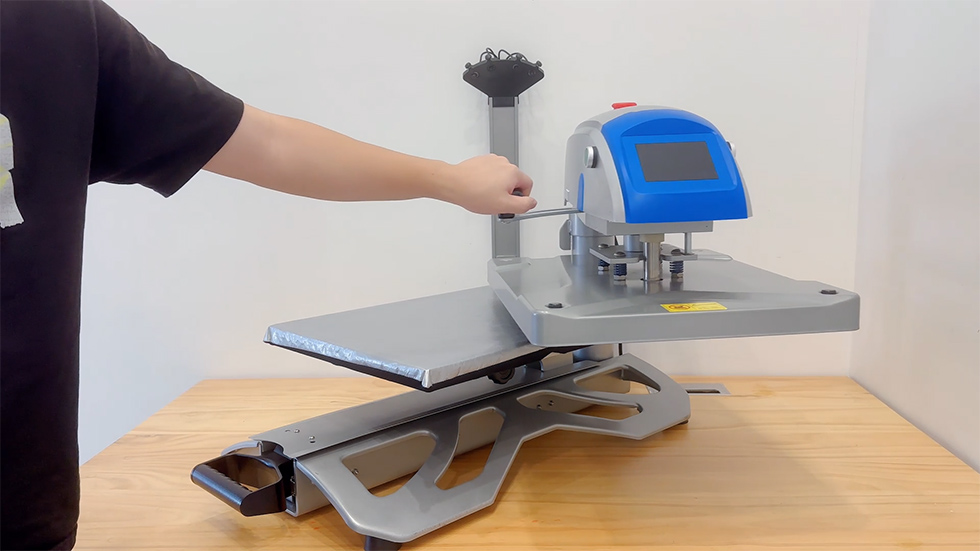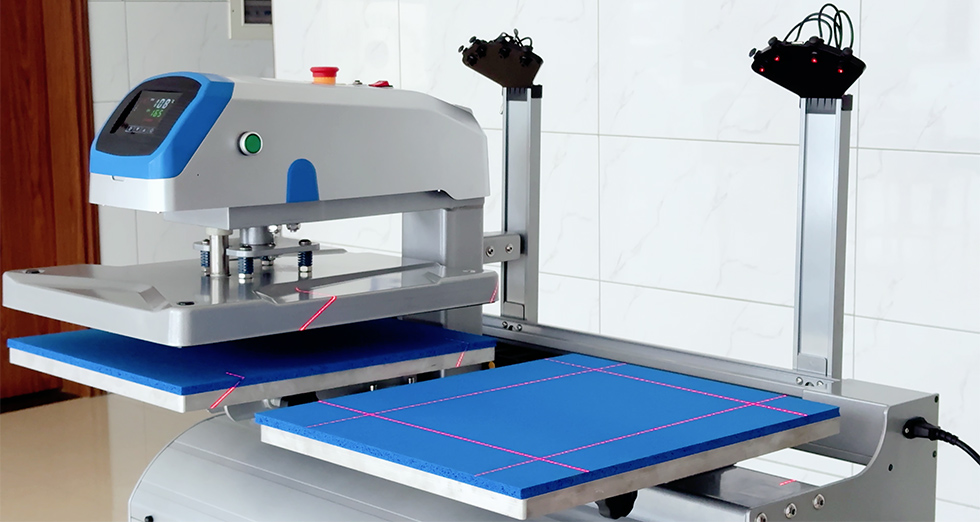When purchasing the first heat press, professional printing factories need to consider production scale, product category, printing process and budget. This article will start from the core role and type of heat press, key technical parameters, purchase points, craft matching and operation and maintenance, to help printing factory owners make scientific decisions and purchase the first heat press that suits their needs.
The heat press can firmly transfer patterns to various textiles and special-shaped carriers through high temperature and high pressure. It is the core equipment for clothing customization, home gifts and industrial label production. Its stability and consistency directly affect product quality and production efficiency.
Clamshell type: The upper plate has a small opening angle and a compact structure. It is suitable for small workshops with limited space, but large are inconvenient to operate.

Swing Away machine: The upper plate can be swung back and completely away from the worktable, which is suitable for printing special-shaped products and large items such as hats and aprons. It is flexible to operate but occupies a slightly larger area.
Draw/Swing Away machine: The lower plate can be pushed out, which can safely remove the parts and reduce the risk of scalding. It is suitable for high-frequency operation scenarios.

Dual Platen machine: Two heating plates work alternately. When one side is being pressed, on the other side you can prepare materials, and the production capacity is increased by at least 50%.

Multi-function all-in-one machine: It integrates multiple transfer platens such as hats, cups, and shoes, which is suitable for small and medium-sized multi-category customized factories.
When purchasing a heat press, the core parameters include the size of the heating plate, temperature range, pressure mode, power configuration and control method, etc., as shown below:
Parameter Key points Common specifications
Heating plate size Determines the maximum transfer area and should match the size of the main product 16×20″, 15×15″, 12×15″
Temperature range The wider the temperature, the more applicable processes; accuracy ±1℃ improves printing consistency 0–220℃
Pressure mode Electric type has low noise and easy maintenance; pneumatic type has higher pressure and quick response Electric/pneumatic
Time control 0–999 seconds adjustable, some models support multi-segment program storage LCD digital display, multi-segment preset
Power supply Power determines the heating speed and stability; the workshop circuit carrying capacity needs to be considered 110V/1800W or 220V/2000W
Structural material Cast aluminum or steel frame structure to ensure flatness and rigidity and avoid deformation under long-term high temperature Cast aluminum heating plate, steel frame body
Safety and auxiliary Automatic lid opening, anti-pinch protection, laser alignment and other functions improve operational safety and efficiency Magnetic or electric automatic lid opening; laser guidance
Certification standards CE, UL, UKCA and other international certifications to ensure equipment stability and electrical safety CE/UL/UKCA
Small batch and multiple categories: optional multi-function all-in-one machine or small-size clamp machine, flexible process switching.
Medium and large batch single product: give priority to double-station electric models to ensure seamless and continuous operation.
Printing of special-shaped parts: hats, shoe tongues, etc. require rocker or downward-moving models to avoid interference with the press plate.
Choose models with cast aluminum plates, heavy steel frames and high-quality motors, give priority to industry brands such as HeatPressLeader and Xinhong, and one-year warranty and lifetime technical support are more guaranteed.
Intelligent configurations such as automatic lid opening, laser alignment, program preset, and fault self-diagnosis can reduce training costs and improve operational stability.
Compare the heating speed, standby power consumption and maintenance cost, and select a heating system with fast heating and high heat preservation, and calculate the return on investment cycle in combination with rent, manpower and electricity costs.
Confirm that the equipment has CE/UL/UKCA certification, and has complete anti-pinch and anti-overheating protection; pneumatic models need to be equipped with silencer valves and dry filters to reduce noise and air source moisture pollution.
T-shirts and sweatshirts: DTF, HTV and sublimation processes can be used. The double-station heat press ensures streamlined operation and has a production capacity of up to 600 pieces/day.
Sportswear and functional fabrics: Sublimation process and high temperature continuous pressure can achieve one-piece molding, which is suitable for mass production.
Hat customization: With the arc-shaped hat press head, it provides 360° uniform heating for the front edge of the hat, and a multi-functional hat press head can also be selected.
Cups and wine bottles: The double-head model can operate in parallel, one end prints cups, and the other end prepares materials, which is suitable for merchants to make small batches of multiple styles.
Functional films and gaskets: The electrothermal curing process requires precise pressure and time control, and the dual-station model supports process connection and rapid switching.
Parameter testing: Before the first batch of production, be sure to test the temperature, time and pressure parameters on the waste material and adjust them to the best state.
Alignment and removal: Use laser guides or template fixtures to ensure the accuracy of the pattern. After completion, wait for the press plate to rise completely before removing the parts to avoid burns.
Environmental maintenance: Keep the ground flat and well ventilated, and regularly clean the dust on the machine body and the ground.
Regularly clean the heating plate: Use a soft cloth and special cleaning agent to remove residual glue and ink to maintain heat conduction efficiency.
Lubricate the slide rails and guides: Add high-temperature resistant lubricating oil to the slide rails, hardware hinges and other components every week to ensure smooth sliding.
Tightening and inspection: Check the tightness of the motor, screws and electrical interfaces every month to remove loosening hazards in time.
Calibrate the temperature control system: perform temperature and pressure calibration every quarter to ensure that the display is consistent with the actual situation.
Air source maintenance (if any): maintain a dry, oil-free air source, and regularly replace the pneumatic component seals and filters.
Q1: What are the main differences between the double-station model and the single-station model?
A1: The double-station can work alternately to achieve continuous production without downtime, and the efficiency is increased by at least 50%; the single-station needs to wait for the heating plate to cool/heat up before continuing to work.
Q2: Is the all-electric model easier than the pneumatic model?
A2: The electric model does not require air compressor and air circuit maintenance, has lower noise and simpler maintenance; the pneumatic model has higher pressure and faster response, which is suitable for ultra-large batches and heavy pressure requirements.
Q3: How to judge whether the heating plate is heated evenly?
A3: You can use a temperature bar or thermal imager to detect. The temperature difference on the surface of the heating plate should be controlled within ±5℃ to ensure transfer consistency.
Q4: Do you need to switch models when producing different fabrics?
A4: No need to switch models, just adjust the temperature, time and pressure parameters, and use the corresponding pad or anti-stick film according to the fabric.
When purchasing the first heat press, professional printing factories should make a comprehensive evaluation from multiple dimensions such as production scale, product type, process matching, degree of automation and maintenance cost. The electric double-station heat press has become the core tool for assembly line mass printing production with its advantages of high efficiency, continuous, precise control and low maintenance. Through reasonable configuration and standardized operation, printing factories can achieve the business goals of high production capacity, high quality and sustainable development.